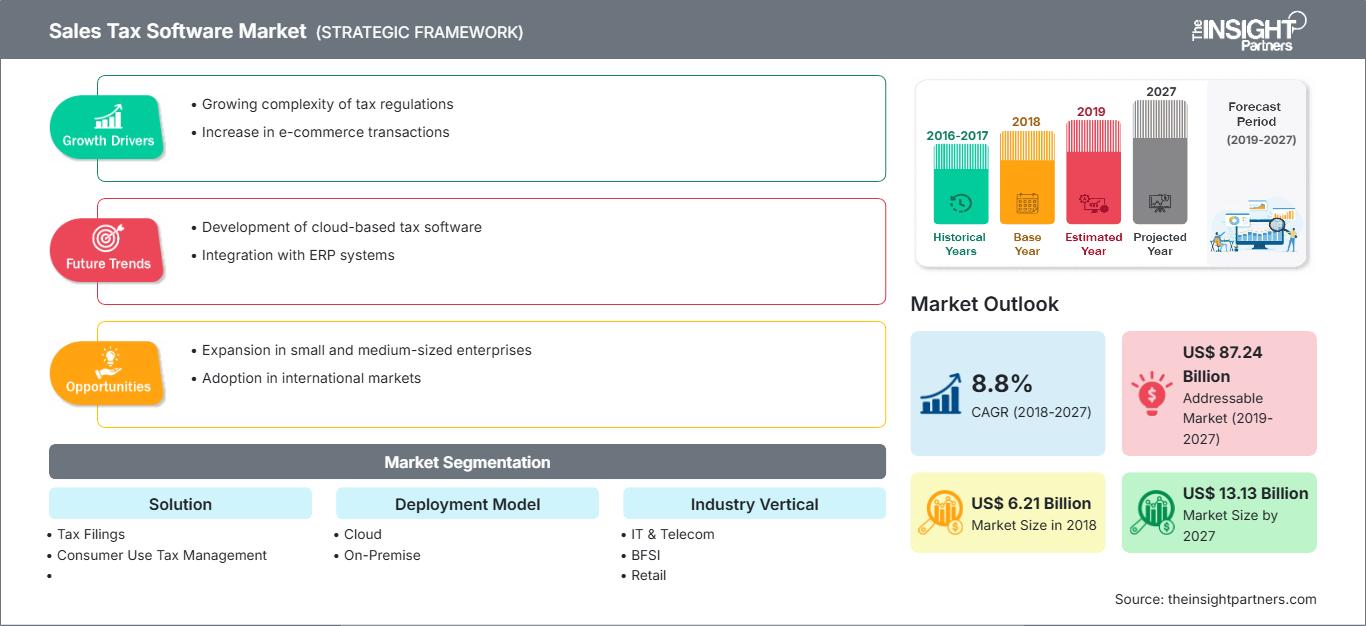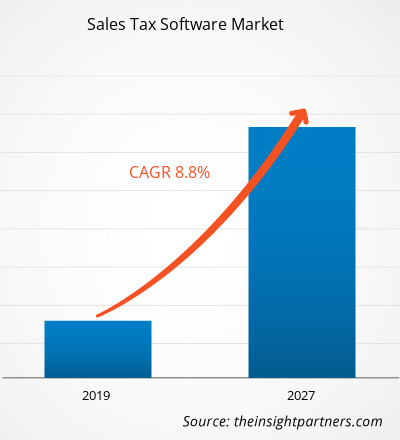[Informe de investigación] El mercado de software de impuestos sobre las ventas ascendió a 6.210 millones de dólares estadounidenses en 2018 y se espera que crezca a una tasa de crecimiento anual compuesta (TCAC) del 8,8% durante el período de pronóstico 2019-2027, hasta alcanzar los 13.130 millones de dólares estadounidenses en 2027.
Entre las diversas regiones geográficas, Norteamérica lideró el mercado de software para el control de impuestos sobre las ventas y se prevé que siga siendo la principal fuente de ingresos durante el período de pronóstico. El crecimiento y la adopción de este software en Norteamérica se deben principalmente a la creciente demanda en diversos sectores, como el comercio minorista, las tecnologías de la información y las telecomunicaciones, el transporte y la sanidad, entre otros.
Perspectivas del mercado
Centrarse en la actualización constante de las leyes y regulaciones fiscales en todo el mundo.
El impuesto sobre las ventas y los impuestos indirectos son importantes fuentes de ingresos para los gobiernos, y una legislación fiscal eficiente y detallada ayuda a las autoridades a recaudar la máxima cantidad de impuestos. Con el aumento del comercio transfronterizo y las ventas minoristas en línea a nivel mundial, junto con las últimas tendencias como el comercio electrónico y la digitalización, las autoridades fiscales de todo el mundo actualizan constantemente sus leyes y reglamentos tributarios para adaptarse a estos nuevos desarrollos en los mercados globales. El impacto de los cambios en las leyes y reglamentos tributarios es incierto y depende de múltiples factores; por lo tanto, las empresas necesitan invertir una cantidad considerable de recursos para comprender y optimizar sus cálculos de determinación del impuesto sobre las ventas. La intervención humana conlleva un alto riesgo de pasar por alto detalles importantes, lo que podría generar errores de cálculo y sanciones por parte de las autoridades. Las grandes empresas comprenden esta necesidad e invierten en la automatización del proceso de determinación y declaración del impuesto sobre las ventas para reducir la posibilidad de errores humanos; sin embargo, las pequeñas y medianas empresas aún se encuentran en proceso de adaptación a la automatización y la digitalización. Por consiguiente, se espera que la continua evolución de las leyes y reglamentos tributarios impulse el crecimiento futuro del mercado de software para el cálculo del impuesto sobre las ventas.
Obtendrá personalización gratuita de cualquier informe, incluyendo partes de este informe, análisis a nivel de país y paquetes de datos de Excel. Además, podrá aprovechar excelentes ofertas y descuentos para empresas emergentes y universidades.
Mercado de software para el control de impuestos sobre las ventas: Perspectivas estratégicas

-
Obtenga las principales tendencias clave del mercado que se describen en este informe.Esta muestra GRATUITA incluirá análisis de datos, que abarcarán desde tendencias de mercado hasta estimaciones y pronósticos.
El aumento de la digitalización está impulsando el crecimiento general del mercado de software de impuestos sobre las ventas.
La revolución de la digitalización a nivel mundial ofrece una gran oportunidad para que las empresas utilicen servicios digitales y automatización para transformar sus modelos de negocio y procesos existentes, incrementando así su eficiencia operativa y sus ingresos. La transformación digital de las empresas consiste básicamente en la integración de la tecnología digital en diversos procesos, actividades y modelos de negocio. La optimización integral de los procesos, la eficiencia operativa, la reducción de costes y la minimización de errores humanos son algunos de los principales impulsores de la transformación digital en cualquier sector. El cambio de paradigma de las empresas, pasando de procesos tradicionales a procesos digitales y automatizados, ha generado múltiples beneficios, desde una mayor eficiencia hasta la reducción de costes y el aumento de las oportunidades de ingresos. Además, gracias a los avances tecnológicos en computación y almacenamiento en la nube, el potencial de las plataformas en la nube se ha multiplicado exponencialmente en la última década. Esto ha creado nuevas oportunidades para que las empresas opten por software de impuestos sobre las ventas basado en la nube.
Información sobre los componentes
El mercado global de software para el cálculo y la presentación de impuestos, segmentado por componentes, estuvo liderado por las soluciones de determinación y presentación de impuestos. Las soluciones de gestión de documentos de cumplimiento ocuparon el segundo lugar en el mercado de software para el cálculo de impuestos en 2018 y se prevé que aumenten su participación durante el período de pronóstico de 2019 a 2027.
Información sobre el tipo de implementación
El mercado global de software para la gestión de impuestos sobre las ventas, segmentado por tipo de implementación, estuvo liderado por la nube. Las empresas se inclinan cada vez más por el software basado en la nube, ya que las declaraciones de impuestos se respaldan automáticamente en servidores seguros. El software en la nube permite a las empresas expandirse rápidamente sin realizar grandes inversiones en su infraestructura tecnológica, dado que las tecnologías en la nube se adaptan con gran facilidad a los cambios acelerados. Además, se adaptan a entornos normativos y de informes dinámicos.
Perspectivas verticales de la industria
El mercado global de software para la gestión de impuestos sobre las ventas se segmenta por sectores verticales en banca, servicios financieros y seguros (BFSI), comercio minorista, TI y telecomunicaciones, transporte, sanidad y otros. En 2018, el comercio minorista ostentó la mayor cuota de mercado en el sector global de software para la gestión de impuestos sobre las ventas y se prevé que mantenga su posición dominante durante el periodo de previsión de 2019 a 2027. Otros usuarios finales de este software incluyen los sectores de energía, manufactura, educación y hostelería.
Los actores del mercado de software para el cálculo de impuestos sobre las ventas se centran principalmente en la mejora de sus productos mediante la implementación de tecnologías avanzadas. La firma de acuerdos de colaboración, contratos, empresas conjuntas, financiación y la apertura de nuevas oficinas en todo el mundo permiten a las empresas mantener su presencia de marca a nivel global. A continuación, se enumeran algunos de los avances recientes en el mercado global de software para el cálculo de impuestos sobre las ventas:
2019: Sovos Compliance y Tytho firmaron un acuerdo de colaboración estratégica para consolidar su liderazgo en el sector fiscal y apoyar la implementación de las soluciones de Sovos Compliance, además de promover su producto.
2017: TaxJar cerró una ronda de financiación Serie A de 60 millones de dólares liderada por Insight Venture Partners. La financiación más reciente, de 2 millones de dólares, fue liderada por Rincon Venture Partners y Daher Capital en 2014. Esta inversión permitió a la empresa centrarse en el desarrollo de productos y estrategias de negocio.
2018: Ryan amplió su alianza con Avalara para ofrecer servicios de consultoría a empresas de combustibles que buscan migrar sus sistemas ERP para optimizar la determinación y la presentación de impuestos.
Perspectivas regionales del mercado de software de impuestos sobre las ventas
Los analistas de The Insight Partners han explicado en detalle las tendencias regionales y los factores que influyen en el mercado de software para el cálculo de impuestos sobre las ventas durante el período de previsión. Esta sección también analiza los segmentos y la geografía del mercado de software para el cálculo de impuestos sobre las ventas en Norteamérica, Europa, Asia Pacífico, Oriente Medio y África, y Sudamérica y Centroamérica.
Alcance del informe de mercado de software de impuestos sobre las ventas
| Atributo del informe | Detalles |
|---|---|
| Tamaño del mercado en 2018 | 6.210 millones de dólares estadounidenses |
| Tamaño del mercado para 2027 | 13.130 millones de dólares estadounidenses |
| Tasa de crecimiento anual compuesto global (2018 - 2027) | 8,8% |
| Datos históricos | 2016-2017 |
| período de previsión | 2019-2027 |
| Segmentos cubiertos |
Por solución
|
| Regiones y países cubiertos |
América del norte
|
| Líderes del mercado y perfiles de empresas clave |
|
Densidad de los actores del mercado de software de impuestos sobre las ventas: comprensión de su impacto en la dinámica empresarial
El mercado de software para el cálculo de impuestos sobre las ventas está creciendo rápidamente, impulsado por la creciente demanda de los usuarios finales debido a factores como la evolución de las preferencias de los consumidores, los avances tecnológicos y una mayor conciencia de las ventajas del producto. A medida que aumenta la demanda, las empresas amplían su oferta, innovan para satisfacer las necesidades de los consumidores y aprovechan las nuevas tendencias, lo que impulsa aún más el crecimiento del mercado.

- Obtenga una visión general de los principales actores del mercado de software de impuestos sobre las ventas.
MERCADO GLOBAL DE SOFTWARE DE IMPUESTOS SOBRE LAS VENTAS – SEGMENTACIÓN DEL MERCADO
Por componente
- Soluciones para la determinación y presentación de impuestos
- Soluciones de gestión de documentos de cumplimiento
- Servicios
Por tipo de implementación
- Nube
- En las instalaciones
Por sector vertical
- BFSI
- Tecnologías de la información y telecomunicaciones
- Minorista
- Cuidado de la salud
- Transporte
- Otros
Por geografía
-
América del norte
- A NOSOTROS
- Canadá
- México
-
Europa
- Francia
- Alemania
- Reino Unido
- Rusia
- Italia
- El resto de Europa
-
Asia Pacífico (APAC)
- Corea del Sur
- Porcelana
- India
- Japón
- Australia
- Resto de Asia Pacífico
-
Oriente Medio y África (MEA)
- Arabia Saudita
- Sudáfrica
- Emiratos Árabes Unidos
- Resto de Oriente Medio y África
-
Sudamérica (SAM)
- Brasil
- Argentina
- El resto de SAM
Perfiles de empresas
- APEX Analytix
- Avalara, Inc.
- Ryan, LLC
- El Grupo Sage Plc
- Sovos Compliance LLC
- Taxjar
- Corporación Thomson Reuters
- Vertex, Inc.
- Wolters Kluwer (CCH Incorporated)
- Xero Limited
- Análisis histórico (2 años), año base, pronóstico (7 años) con CAGR
- Análisis PEST y FODA
- Tamaño del mercado, valor/volumen: global, regional y nacional
- Industria y panorama competitivo
- Conjunto de datos de Excel
Informes recientes
Informes relacionados
Testimonios
Razón para comprar
- Toma de decisiones informada
- Comprensión de la dinámica del mercado
- Análisis competitivo
- Información sobre clientes
- Pronósticos del mercado
- Mitigación de riesgos
- Planificación estratégica
- Justificación de la inversión
- Identificación de mercados emergentes
- Mejora de las estrategias de marketing
- Impulso de la eficiencia operativa
- Alineación con las tendencias regulatorias






















 Obtenga una muestra gratuita para - Mercado de software de impuestos sobre las ventas
Obtenga una muestra gratuita para - Mercado de software de impuestos sobre las ventas